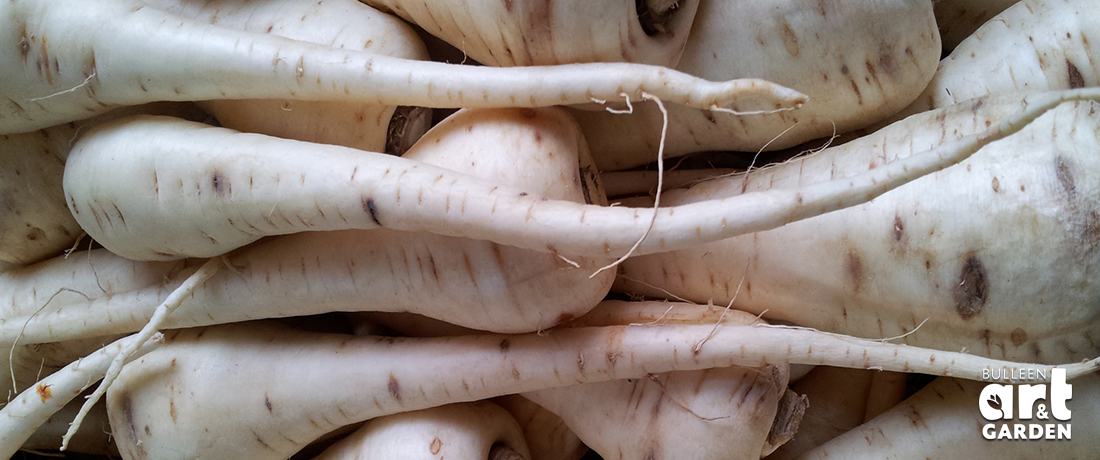
 Important note about plant availability. Important note about plant availability.There are hundreds of factsheets on our website provided for your information. Not all plants will be available at all times throughout the year. To confirm availability please call (03) 8850 3030 and ask for the nursery. |
If you like parsnips and live in Victoria, then you are in luck, we have the perfect climate for them. Parsnips have a reputation for being tricky to grow, but that is a bit unfair. Yes, there are a few traps to avoid, but this is easily done, and good, sweet nutty roasted parsnips are such a joy that it is worth learning a few tricks of the trade. The humble parsnip (Pastinaca sativa) may not be everyone’s favorite vegetable, but grown well and prepared to a good recipe in the kitchen these white carrot relatives can be a delicious variation in your home grown meals.
A vegetable grown from ancient times, Parsnip was a solid staple harvested for winter eating where other foods may have been scarce. Parsnip is a good source of fibre, Vitamin C, Folate and Manganese.
Planting
Here is where you avoid the first trap: Seed must be fresh – old seed will not germinate. Check the use by date on your seed packet before you buy. It will not keep, use all the seed within the year.
Now straight onto the second easily avoided trap – don’t plant into cold soil, they need warmish soil to germinate – around 12C, so late September is the absolute earliest. Depends on where you live and how early spring comes each year. In Melbourne, you can continue to sow seed into May, allowing you to harvest parsnips right into spring. The tops grow vigorously and can take up a fair bit of room, so space rows 30cm apart.
Plant directly into the garden bed, avoid germinating in seedling trays and transplanting. Parsnip seeds germinate by initially sending down a tap root, and only then do they send up a stem and leaves. By the time the leaves are clearly ready to transplant, the root is too long for the tray and has hit the bottom, leading to deformed roots when you transplant. If you need to, thin seedlings after germination.
Parsnips do best in poor soil, much like carrots. This is a useful characteristic, as they work very well into your crop rotation, plant after hungry winter brassicas (cauliflowers, cabbages and broccoli) and till the soil so it is nice and loose, no need to fertilise. A loose, poor soil helps you avoid the tap roots splitting or forking. Do remember that parsnips are a deep root crop, so you will need to fork and loosen soil to a depth of 40cm.
Be patient, if you are getting your parsnips into the ground in spring, they can take a few weeks to germinate. If you are planting in summer, they can sprout in as little as a week. They are very temperature dependant. Keep the ground evenly moist while you wait for them to germinate.
Growing
Parsnips need to be grown in full sun and best grown in a deep sandy, loamy soil. Use well aged manure, as fresh manure can cause the Parsnip to fork instead of having one nice long root. A low nitrogen fertilizer such as Rockdust would be beneficial also for good growth.
It is important to always use fresh seed to plant out at the beginning of spring. Germination is more successful if the soil is lightly pressed with a timber board and kept moist but not soaked for about 3 weeks. When sowing the seeds, sow thickly and when the seedlings are 2.5cm high keep thinning out the weaker seedlings until about 20-20cm apart. To prevent soil from crusting, a light layer of vermiculite can be used or alternatively you can plant parsnips with radish seeds which will emerge earlier and prevent a soil crust.
Keep the planted area free from weeds competing for the soil, from spring to early autumn. Keep the crop moist but again, not too wet. The trick to a good flavoured parsnip is to harvest in late autumn or winter after the first couple of frosts. The cold results in the starch in the roots being converted into sugars that gives the parsnip flesh its sweet, nutty taste.
Once they have germinated they are relatively easy. No need to muck around adding extra fertiliser. Just weed and keep evenly moist, mulching helps. Wildly fluctuating moisture levels leads to forking and splitting roots – so mulch and water as needed.
Harvesting
When harvesting the roots, dig them up and twist off the leaves to prevent the flesh going rubbery. There are a few varieties available for planting in Australia such as Albion and Gladiator. Harris Model is one of the oldest and best yielding varieties. Hollow Crown is a reliable grower with long smooth flesh and a delicious flavour. Guernsey is a medium size, firm, white skin with a nutty flavour. Frost is your friend, it sweetens them up as the starches are converted to sugar. Leave them in the ground for as long as you like, the ground doesn’t freeze, so you can pull them all winter. Be careful digging them up – avoid wounding the parsnip with the fork prongs.
Give parsnips a go in your garden and you will be harvesting these little beauties and making your own delicious Parsnip Soup and other gourmet delights in no time.
Parsnips take around 4 months to be ready for harvest.
